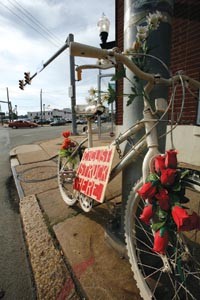At first glance, it'd pass as a forlorn abandoned bike. Chained to a utility pole on Craig Street near Fifth Avenue in Oakland, a road bike is painted all white with plastic geraniums tucked in its spokes. Perhaps it is fitting that the rear wheel, covered with streaks of white paint, is mangled as though it had survived an accident.
Dubbed a "ghost bike" by cycling advocates, it marks the spot where a motorist hit a cyclist. The accident marked by the Craig Street bike happened earlier in the summer when a cyclist collided with a car turning out of a side street. The cyclist sustained with a few broken bones.
Stung by a rash of hit-and-run accidents and attacks against cyclists earlier in the spring, some biking activists decided to act. [See City Paper: "Vicious Cycle" May 17, 2007] Over the past two weeks, four other ghost bikes were put up in Oakland and Squirrel Hill, and a few will appear in parts of Downtown.
Although local cyclists are often outspoken, they've kept mum about who is behind the bikes' installation. In years past, ghost bikes have cropped up sporadically to mark a car-bike flashpoint. The ghost bikes have been more visible lately, because of an increase in accidents, according to bike advocates. The exact number is unknown, however, because not all bike accidents are reported.
The Ghost Bike project -- www.ghostbike.org -- has seven registered initiatives in the United States and Canada. The Web site suggests using a junked bike, painted white, and affixing it to the area where a cyclist has been hit under "the cover of darkness." (Such memorials may not be legal.) The legality of chaining an abandoned bike on public right of way remains murky to the cyclists.
"It's not legal to affix something to city property," says Pittsburgh police spokeswoman Diane Richard. "But people fix their bikes to [city property]; it's something we've grown accustomed to.
"So long as the ghost bikes don't block pedestrians or traffic," she continues, "we don't see that poses a great problem."
Erok Boerer, membership and project director for the advocacy group Bike Pittsburgh, is sympathetic with the clandestine efforts, though he says the group is not involved.
"This is an awareness-raising campaign -- and art to reflect what we're going through," says Boerer. "People aren't looking out for us."
Boerer is hopeful that the safety measures being implemented by the city will afford the cyclists more space -- and protection -- on the roadway. For example, in June, new markings and lane lines were painted on a well-pedaled stretch of Liberty Avenue in Bloomfield to demarcate the city's first-ever commuter bike lanes. More such lanes will be laid down in Squirrel Hill. Bike Pittsburgh is currently surveying road users about their experience with the Bloomfield lane.
Apparently the apparition of ghost bikes has sparked discussions on message boards among concerned road users. "Some people said: '[The ghost bikes] really touched me. They made me think twice and realize that you guys are really out there,'" says Boerer.
Out on the street, however, the Craig Street ghost bike seems largely invisible. Half-a-dozen students passing the bike said they never noticed it (until City Paper called their attention to it) and had no clue what it was about -- despite the wooden sign it bears reading: "Cyclist hit here."
Waiting in his Cadillac cater-corner from the bike, Arthur Gilkes says he gets it. "Some drivers have no concern for cyclists," says Gilkes. "They want to strike the fear of God into cyclists." He says he tends to brave city streets with his car but enjoys hitting the trails on Beechwood Boulevard in Squirrel Hill on two wheels.
Gilkes, a lawyer, says, the bikes should be permitted on a public right-of-way. "It's a statement of First Amendment import."


